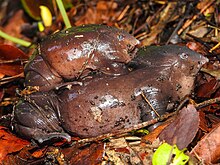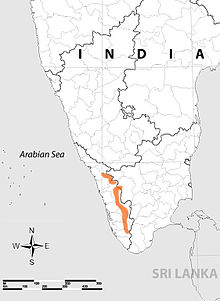Purple frog
| Purple frog | |
|---|---|

| |
| Nasikabatrachus sahyadrensis | |
| Calls of Nasikabatrachus sahyadrensis | |
| Scientific classification | |
| Domain: | Eukaryota |
| Kingdom: | Animalia |
| Phylum: | Chordata |
| Class: | Amphibia |
| Order: | Anura |
| Family: | Nasikabatrachidae |
| Genus: | Nasikabatrachus |
| Species: | N. sahyadrensis
|
| Binomial name | |
| Nasikabatrachus sahyadrensis Biju & Bossuyt, 2003
| |

| |
| Distribution range of Nasikabatrachus sahyadrensis (in ORANGE) | |
The purple frog (Nasikabatrachus sahyadrensis) is a frog species in the family Sooglossidae.[2] It lives in the Western Ghats in India. Common names for this species are Indian purple frog, pignose frog or doughnut frog. It was discovered by S.D. Biju and F. Bossyut in October 2003.
This frog's body is shaped similarly to that of most frogs. It is somewhat rounded. It has a small head and an unusual pointed snout. Adults are typically dark purple in color. Its cry sounds more like one from a chicken.
The frog spends most of the year underground. It comes out only for about two weeks, during the monsoon. This is to mate.
Unlike many other digging species of frogs that feed above the ground, this species eats underground. They feed mainly on termites using their tongue.
The purple frog has one close relative, Bhupathy's purple frog, which also lives in the Western Ghats.[3] [4] [5]
The purple frog starts off living their life at the base of land, but as they get older their bone structure morphs into a structure that becomes efficient for digging into dirt. This allows them to live a majority of their lives underground. Males will rarely come to the surface for mating purposes.
Other ideas[change | change source]
Scientists say that because the purple frog and Bhupathy's purple frog have close relatives in the Seychelles, which are close to Africa, it is likely that the Gondwanaland idea of why the continents are where they are is right. This idea says that Africa and India used to be one large continent, called Gondwanaland.[4]
References[change | change source]
- ↑ S.D. Biju (2004). "Nasikabatrachus sahyadrensis". The IUCN Red List of Threatened Species. 2004: e.T58051A11722468. doi:10.2305/IUCN.UK.2004.RLTS.T58051A11722468.en.
- ↑ Frost, Darrel R. 2006. Amphibian Species of the World: an online reference. Version 4.0 (17 August 2006). Electronic Database [1]. American Museum of Natural History, New York, USA.
- ↑ Jason Bittel (August 24, 2017). "New Purple Pig-Nose Frog Found in Remote Mountains". National Geographic.
- ↑ 4.0 4.1 Aathira Perinchery (August 23, 2017). "'N. phupathi', a frog with the face of a pig". The Hindu.
- ↑ S. Jegath Janani, Karthikeyan Vasudevan, Elizabeth Prendini, Sushil Kumar Dutta, Ramesh K. Aggarwa (July 31, 2017). "A new species of the genus Nasikabatrachus (Anura, Nasikabatrachidae) from the eastern slopes of the Western Ghats, India" (PDF). Alytes.
{{cite web}}: CS1 maint: multiple names: authors list (link)

